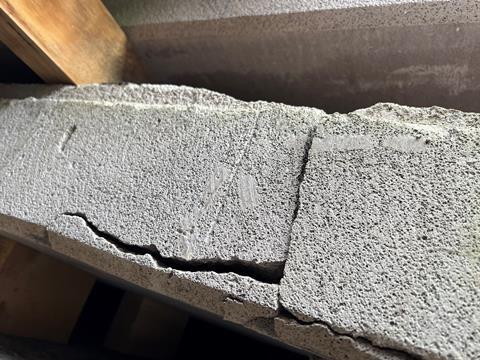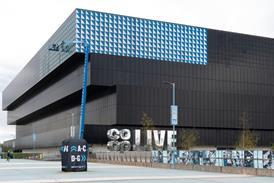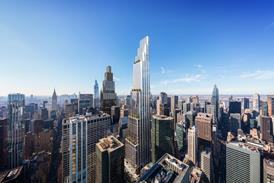We need to design buildings with flexibility and long-term maintenance in mind, and then look after them, writes Alex Lynes

As part of my work, I’m often involved in inspecting existing buildings – investigating and diagnosing any damaged or failing areas, typically caused by overloading, insufficient maintenance, and water ingress. But recently I’ve noted a phenomenon in buildings constructed with Reinforced Autoclaved Aerated Concrete (RAAC) — the damage has no clear cause apart from the passage of time.
This conundrum of RAAC, which reached crisis levels last summer, reveals nuanced issues with the way buildings are designed and constructed — issues that are worth interrogating to inform new approaches to building for a low-carbon future. A well-maintained building of any material should be able to last forever if designed and built in a way that facilitates repair.
In the UK, most buildings are already beyond their anticipated design life. Understanding them is critical to effective maintenance, repair, and ultimately forestalling obsolescence.
It has always been the case that all structures need to be understood and maintained. Steel corrodes over time and needs repainting; masonry is susceptible to moisture and will crumble if it isn’t allowed to dry out. RAAC just fails faster and more catastrophically than other materials. But instead of acknowledging the maintenance requirements of our homes, offices, and schools, we have started believing buildings are eternal just as they have become more complex, fragile, and perishable.
In the past 150 years, our buildings have transformed. They used to be simple structures made from a few materials used in ways that had been understood for hundreds of years. Now, they are made up of hundreds of different high-tech materials, all of which tend to be fragile and prone to wear. RAAC is one of these.
On its surface, RAAC seems like the perfect building material. It’s lightweight, cheap to mass produce, quick to build with, and reasonably durable. Unfortunately, the lightweight property of these planks is both its strength and its downfall. Aerated concrete is significantly weaker than solid concrete and doesn’t offer the same protection to the rebar. It’s porous and fragile, meaning it doesn’t protect the rebar from rusting, fire or water ingress.

It’s also more prone to internal cracking around the bars, which can lead to sudden failure — not a desirable feature in any structure. In addition, it is very difficult to maintain as the degradation of the material is internal and often unseen. All of this explains why the life expectancy of RAAC is about 25 years, significantly lower than the typical 50+ years of most materials.
But even its comparatively short lifespan isn’t the real issue with RAAC. Instead, it’s the misunderstanding of the material between the construction industry and clients. Most buildings using RAAC were built quickly and cheaply to provide essential spaces such as schools and universities when they were needed most. They were meant to be a medium-term solution that would be replaced with something more substantial in the future.
Did the clients really understand this and build it into their development planning? Almost certainly not. And this is where the issue lies — with owners’ understanding of how permanent buildings really are. Buildings require upkeep, they require care, they require inspections and, sometimes, they require replacing parts when they wear out.
Unfortunately, repairing RAAC panels is not really a viable option, so some form of replacement will likely be required. Most current proposals involve replacing entire buildings with shiny new ones, which will inevitably be built from ‘indestructible’ solid concrete or steel. But, in a climate emergency, is this really the best option?
Those existing materials hold a lot of embodied carbon, and the rest of the buildings are normally in good condition. It’s only the RAAC planks that are failing. So, what is the alternative? A material that takes a similar form and is equally lightweight. To me, the answer is obvious: CLT planks.
Crucially, we all need to take better care of our buildings
Cross Laminated Timber (CLT) planks are slightly lower density than RAAC, about the same thickness for the spans, readily available, and quick and easy to install. They also have better fire resistance, less deflection, and are easier to tie together to form robust roofs. They can be left exposed, creating pleasant, natural-feeling spaces, and existing services or other fixtures can be easily screwed into them. While we’re installing them, we could also seize the opportunity add better insulation to the roofs, reducing running costs.
More importantly, the construction industry needs to learn from the RAAC crisis for our future designs and buildings. One take-away might be that we should make our buildings as durable as possible, avoiding this problem in the future by just having them never wear out. But that’s a fool’s dream. Buildings will never last forever, and the carbon and cost involved with making them stronger than they need to be would be a waste.
What we need to do is design our buildings to be adaptable and resilient. They should be able to withstand unexpected conditions and be easy to maintain and repair. Then, crucially, we all need to take better care of our buildings.
We need to understand that nothing lasts forever, and it is our duty to repair, replace or upgrade them to extend their lifespan. This will require not just better understanding of the materials, but also designers clearly explaining to owners the responsibility to protect and shepherd our built environment into the future.
>> Also read: The RAAC schools crisis: what we know so far
Postscript
Alex Lynes is an associate director at Webb Yates Engineers
















No comments yet